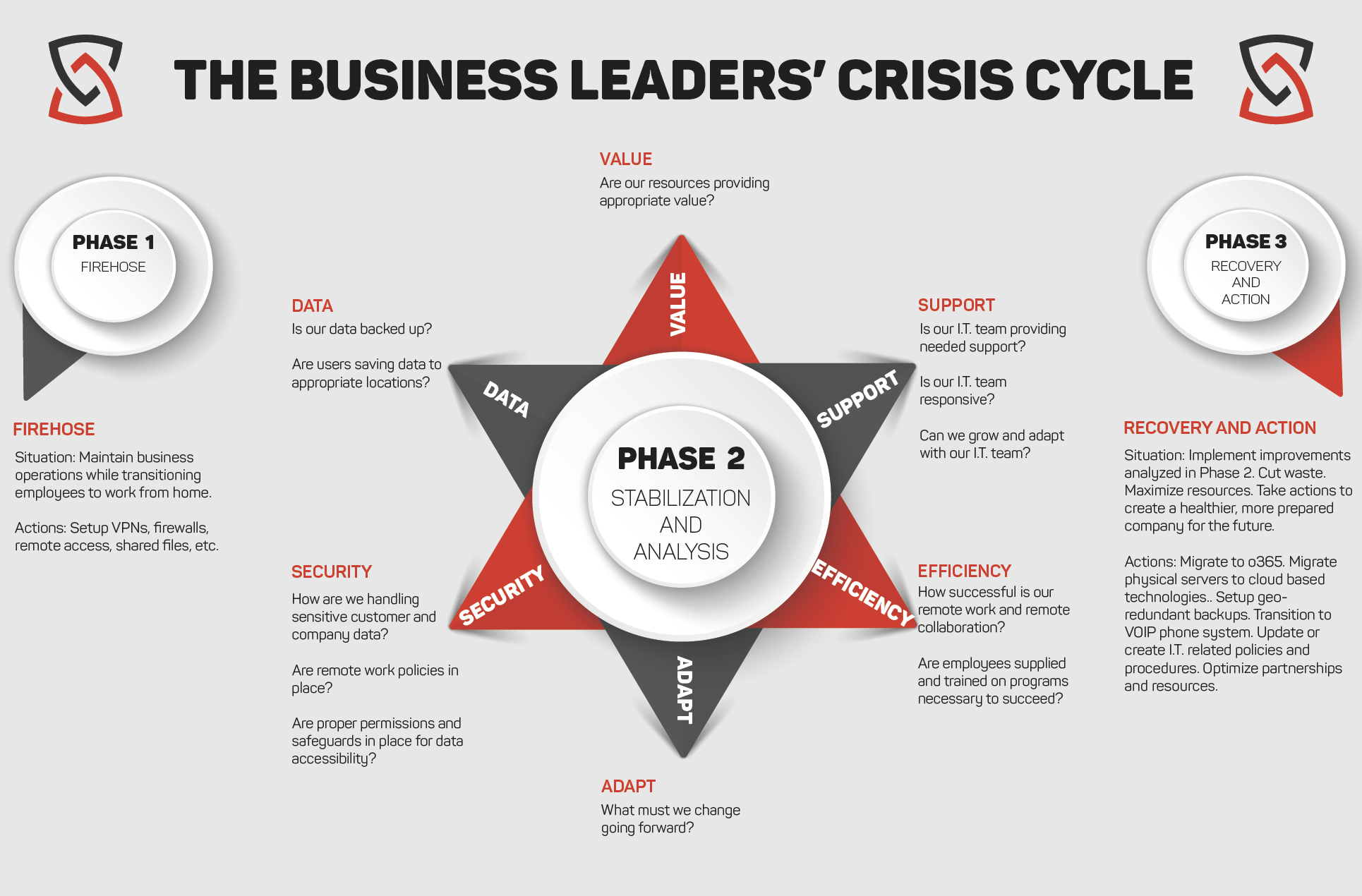Crisis Cycle of a Business Leader - Guest Post Wasatch I.T.

CRISIS CYCLE OF A BUSINESS LEADER

We had certainly heard of the virus in January. But on a trip to follow the Utah Jazz to Boston and New York in early March, you could see its impact emerging. While we didn’t know what it would look like, it was clear things were different.
Admittedly, a lot of the precautions were fantastic. Being more germophobic than the average person, the increased attention to sanitation was welcomed. I distinctly recall riding the escalator at Madison Square Garden for the Jazz v. Knicks game and arriving at the top to see an MSG employee holding a disinfecting wipe to the handrail – ensuring a clean surface for the new set of riders. If only this level of sanitation remained forever.
Little did we know that only a few days later, the world would turn upside down. Back home, we were preparing for dinner and watching the Jazz pregame. The game was just about to tip off when action abruptly stopped, teams were sent to locker rooms, the game was postponed, and the entire NBA season was suspended.
It was official. It was here.
Three Phases
Governor Herbert released “Utah Leads Together,” outlining the three phases of the COVID-19 crisis. As a business leader, it feels we’ve more or less gone through three phases of our own.
Phase 1
Governor Herbert classified this phase as “Urgent.” Businesses were forced to shut down and/or completely adapt their operations, implement working from home, and strict social distancing. I’d classify this phase as “Firehose.”
Cue the I.T. folks.
Instantly, our help desk was flooded with requests. Our workload more than doubled overnight. As the I.T. department for hundreds of companies, immediately transitioning customers and their users to full or partial work from home arrangements, on top of day-to-day issues, was like drinking from a firehose. One timeless trend in I.T. support is no matter the issue, more likely than not the user believes it is the highest priority and expects an immediate resolution. Things were no different now. While we tried to resolve everything as quickly as possible, we (gasp) were meeting our SLA’s, but far the norm of greatly exceeding them. This increased ticket flow caused a lot more triaging and kept our team on their toes.
An HBR article, “Supporting Customer Service Through the Coronavirus Crisis,” posted April 8, 2020, highlighted not only the spike in customer service calls through this crisis, but also analyzed the “effort level” of a customer interaction. The number of calls classified as “difficult” more than doubled, citing increased customer emotion and anxiety. Completely understandable. However, it is crucial to remember the agent on the other side of the phone isn’t immune from the stresses of the crisis either. Everyone was stressed. Everyone was adjusting. Everyone was navigating the unknown. Everyone seemed to be in firehose mode. The increased pace of life made time fly by at a disturbingly shocking rate. In spite of this additional stress on our team and our customers, attitudes, optimism, and patience on all sides remained admirably positive.
This phase felt chaotic. It was filled with constant ticket triage. Time was flooded with getting our customers networks up, getting their employees functional to work from home, setting up outdoor COVID testing networks for healthcare clients, keeping up with the onslaught of day-to-day requests, and managing the morale, sanity, and culture of our team. There is no doubt why I.T. support companies like ours are classified as essential services. For our customers to work to the best of their abilities, to keep their companies functioning, generating revenue, being productive, providing for others in the community, our team had to be there. And, for the sake of the world, they had to do so with positive attitudes, quick resolutions, and as much awesomeness as we could provide. Our team sought to keep business as usual as much as possible to support our customers’ networks and business operations. Our team understood its role in this crisis and stepped up to the challenge. We stayed socially distant and neurotically sanitized, but still working as needed at customer sites. Our team had to be committed, and they were.
Then, the earthquake hit. After the “thank goodness it wasn’t worse,” replaced the “you’ve got to be kidding me,” it was checking on the safety of our team. A challenge worthy of its own moment, hitting during an already stretched environment. We were experiencing the peak in support ticket counts and now faced downed customer networks during a time remote access was even more imperative. Within minutes of the earthquake, we had technicians reporting their families were safe and that they were headed to downed customer sites to get them up and going. Multiple healthcare customers had their networks impacted by the earthquake, and in the middle of a pandemic, there was no time for them to be nonfunctional. Our team’s resolve was amazing. In spite of any uncertainty, fear or stress, they remained on course and stepped up. During one of the largest aftershocks that afternoon, I could hear techs on the floor continuing their calls as if the building wasn’t shaking. I received multiple emails from customers commending technicians who were on the phone with them during the aftershock and kept working right through it to resolve their issue. The gratitude I felt for my team was overwhelming.
Through what often felt like madness, came invaluable lessons on character. I think we learned something about every person we interacted with during this phase. From employees, family, customers, vendors, locally owned businesses, and of course, ourselves. Seeing the way a person responds to adversity can significantly impact your view of the them. The respect I feel for so many people has grown remarkably. Because of Phase 1, I have never felt more prepared to draft the people I’d want on my team battling next to me.
Phase 2
Governor Herbert classified this phase as “Stabilization.” For business, I’d classify this phase as “Stabilization and Analysis.”
During Phase 1, we anticipated Phase 2 would bring fewer support requests than historical averages. We were wrong. While new business and projects remained stalled and ticket requests inched back towards historical averages, we remained at an increased, albeit, more manageable count. Day-to-day I.T. issues remained, and people became more adjusted to the new, temporary way of life. This rhythm allowed executives to move from hurried survival mode to a state of reflection of Phase 1, managing Phase 2, and looking toward Phase 3 and beyond.
We, like many of our customers, began analyzing how well prepared our company and employees were to handle the sudden shift, improvements we could make to our company or services, and the impact the crisis would have on our customers and the world in general. Many of our customers began engaging us in higher level discussions regarding operations to keep their employees working and companies afloat while working remote. Conversations around increased functionality, accessibility, security measures, controls and trainings for remote employees, and of course, the recognized fallibility of physical hardware the earthquake triggered. This sparked renewed interest in offsite backups, migrations to cloud-based technology, and other steps to remove points of failure triggered by another earthquake or disaster.
Discussions also emerged regarding what the future would entail. Learning from Phase 1 and Phase 2, many companies realized they could easily live without many items previously budgeted. Multiple customers informed us they were rethinking their need for office space. Others realized they needed to pivot into new areas of business and begin working with us to help build out the technical functionality and design of their possible changes. We are even starting to have individuals call from non-customer companies looking to learn more about what we do. Some learned their current outsourced resource didn’t provide them the assistance they needed in Phase 1 and 2. Others reviewed their current structure, often internal I.T., and realized it may be an area to cut costs, increase reliability, and better prepare for the future if outsourced.
Overall, big changes weren’t yet implemented in Phase 2, but the analysis and discussions were alive and well.
Phase 3
Governor Herbert classifies this phase as “Recovery.” For businesses, I’d classify this phase as “Recovery and Action.”
Although we aren’t here yet, I believe Phase 3 will be about implementing and acting upon what was learned in Phase 1 and 2. I anticipate the normalized rhythm in life will remove the anxiety of making changes during a crisis and create the perfect time to move forward with improvements and adaptations. Phase 3 should be about making changes that better position your company to operate in the new normal. While this may look different for every company, I hope some of the lessons we learned through the crisis play a long-lasting role in future decisions. We get to choose who we spend our time around and who we spend our money with. I think more people will seek to hire, employ, contract, and support people and companies they actually want to work with.
I believe this crisis allowed us to learn valuable lessons. We are the architects of our lives. Our actions and decisions shape the people we are, the employees we employ and our companies as a whole. As we are seeing with COVID-19, people with preexisting conditions are hit hardest, and people in better health are more likely to persevere. Our businesses and teams are no different.
If we let problems in our organizations fester, if we avoid decisions that have long term benefits as a result of short-term anxiety, or if we do not force ourselves to continually strive to improve and innovate, we may face the next crisis less prepared or in a weakened state. We never know when the next economic bump, market shift, or earthquake may occur. Wishing you started taking better care of your health mid-COVID infection is too late. Don’t be the company mid-crisis, regretting not implementing known improvements. There is enough we cannot control. We can’t afford to miss out on influencing the areas we can.
Bahar Ferguson is president of Wasatch I.T., a Utah provider of outsourced IT services for small and medium-sized businesses. If your business is analyzing any of these issues and would like to see if we can help, you can reach Bahar at 801-983-3671 x 132 or info@wasatchit.com.

